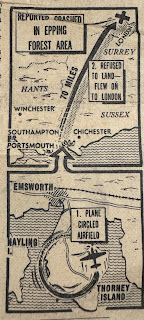Whilst working at RAF Thorney Island my father witnessed a rather unusual incident - one that ended in tragedy when a stolen Vickers Varsity training aircraft crashed near Valenciennes in France, killing three civilians and injuring three others. During the subsequent Court of Inquiry my father, a meteorologist, gave evidence about the weather conditions prevailing at the time.
 |
| Contemporary newspaper reports |
The story is a strange one. At 7 pm on 25th April a Royal Air Force Varsity aircraft took off from RAF Thorney Island, piloted by Leading Aircraftsman Nanik Agnani, an Indian national. No flight plan had been logged, and the departure was not authorised. Indeed, Agnani had failed his Pilot Training Course on account of poor eyesight - he was reported by one journalist as wearing very think glasses, although this was not evident in a head and shoulders mugshot which also featured in subsequent newspaper reports. As the pilot of the stolen aircraft struggled to gain height virtually everyone on the station - 650 in all - turned out to watch the spectacle.
A contemporary newspaper report reported that a twenty year old ground-crew airman, 'Nick, Agnani, took off in a twenty seater training plane and was later seen speeding across London at an altitude which occasionally dipped to 200 feet. Apparently Agnani had fuelled the aircraft up for an eight hour run, leading some to suggest that he was looking to fly the aircraft back to his home town on the sub-continent.
 |
| Vickers Varsity - Copyright BAE Systems |
After a failure to prevent the aircraft leaving the ground at Thorney Island through the positioning of a fire tender on the runway, another Varsity piloted by Flight Commander, Flight Lieutenant Smiles, set off in hot pursuit. Airfield landing lights were switched on at various locations in the vicinity but Smiles lost visual sight of his prey in failing light. At one point Smiles managed to get in front of the stolen aircraft and the other crew member, who was positioned in the Varsity's astrodome, said afterwards that the two planes were briefly within fifteen feet of one another. An eyewitness described the chase to a reporter shortly after the news broke.
It came low over the rooftops. It was in a semi-stalling condition, its' throttle seemed to be fixed, but the pilot kept altering the propellor pitch. I followed the plane with my binoculars, but I could not spot the pilot. He was obviously trying to gain height but kept stalling. He circled to the west of Chichester, over Bosham and Chidham, for about 15 minutes at 1,000 feet. Then a second Varsity appeared and started chasing the first one, going close to give either Aldis or hand signals. They went round and round west of Chichester, coming over Parklands about fifteen times. I expected the first Varsity to crash any minute, and thought it was someone trying to show off".
The stolen Varsity was tracked by radar over the channel and was later spotted circling the military airfield at Trouvy-Valenciennes. The aiircraft lost height and 'exploded' into the side of a small house bringing down the roof and the walls. The house was in the tiny mining village of Vicq and the crash caused the death of three civilians and injuries to three others. Two of those killed, and the three injured, belonged to a Polish mining family. Stephen Skalecki, who had left his native Poland in 1929, lost two of his grandchildren - Vladislav and Stephanie. Madame Henriette Gillerand also lost her life in the stricken property. A tragic end to a foolish act.
 |
| Armstrong Whitworth Argosy at RAF Thorney Island |
The Court of Inquiry failed to discover the reason for Agnani's criminal act. One observer noted that Agnani had enough fuel for 1,700 miles but that India was 4,000 miles away. Other suggestions were that this was an act of treason with the pilot heading for a Warsaw Pact country, or that he was rebelling against his failure to attain a pilot license. Maybe it was simply the case that he was looking for excitement and took a rather extreme course to achieve it. Whether my fathers' meteorological evidence at the Inquiry contributed much to the understanding of what exactly happened is a moot point, but the fact that he kept the cuttings and wrote about the incident in his private diary demonstrates that it left quite an impression on him.














